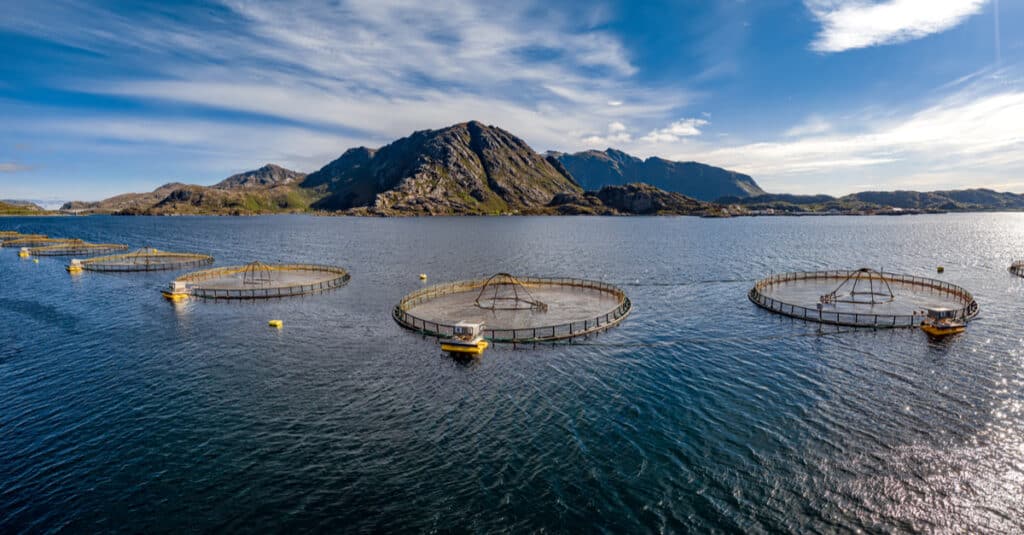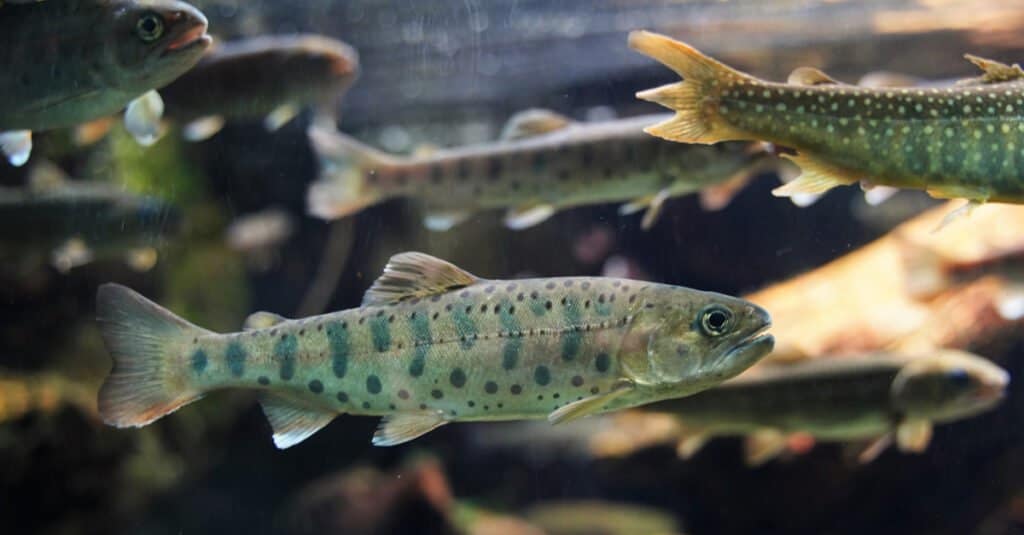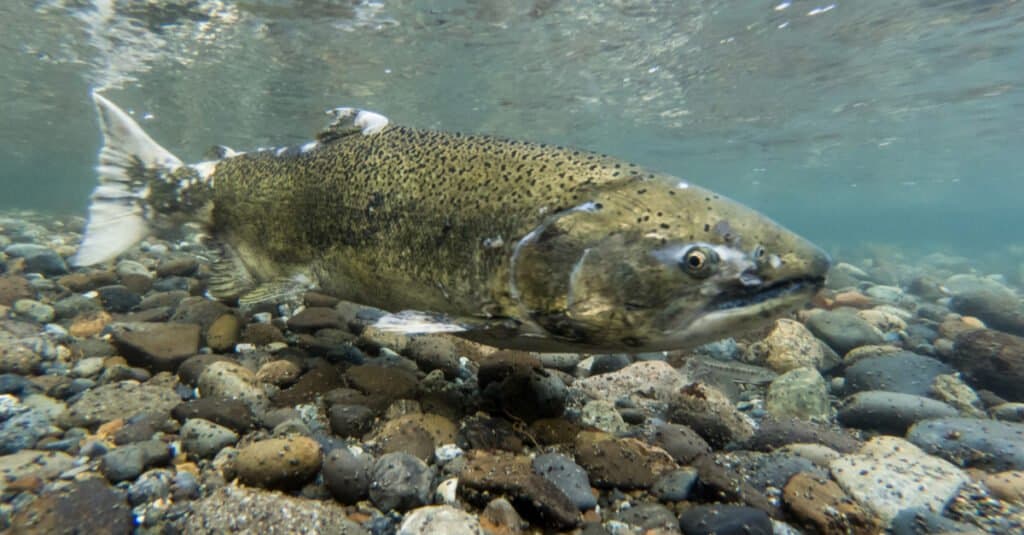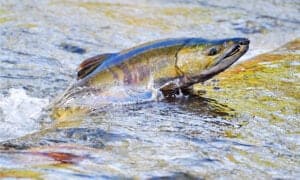Humans are now eating more aquaculture salmon (farmed salmon) than wild salmon. That means more of the highly popular pink fish comes from complex fish farms throughout the world than directly from the ocean itself. This development begs the question, what are the differences between farmed vs wild salmon?
We’re going to take a look at how these two different types of fish vary from one another and why you shouldn’t worry about whether your salmon is raised in aquaculture farms or caught in the ocean.
Comparing a Farmed Salmon and a Wild Salmon

| Farmed Salmon | Wild Salmon | |
| Flesh color | Gray, but it is colored pink like wild salmon to make it more appealing using synthetic astaxanthin | Pinkish orange due to eating shrimp and krill, animals rich in astaxanthin |
| Diet | – Farm-made fishmeal with poultry byproducts, vegetable oils, and a balance of vitamins and minerals | – Worms, squid, crustaceans, and some other fish |
| Maturation Rate | – Mature quicker due to controlled environment. – Reach maturity in about 10-15 months before spending another 14-18 months growing for slaughter. – Average 2 years of age around slaughter – Some systems claim to have table-ready salmon in about 15 months. | – Salmon mature naturally in 2-8 years |
| Nutrition | – Has more calories – A greater amount of protein – Fattier than wild salmon | – Fewer calories than farmed salmon – Slightly less protein – Higher amounts of minerals like calcium and iron |
| Notable Challenges | – Antibiotic resistance in fish and humans – Increased amounts of harmful materials like dioxins and mercury – Disease transfer between Atlantic salmon and Pacific salmon | – Overfishing |
The Key Differences Between Farmed Salmon vs Wild Salmon

Wild salmon consist of many subspecies, but farmed salmon are usually pink and red salmon
©The Old Major/Shutterstock.com
The greatest differences between farmed salmon and wild salmon are their diet, maturation rate, and nutrition. Farmed salmon are fed a highly nutritious, scientifically developed type of feed that gives them all the vitamins, minerals, and fatty acids they need to develop. Wild salmon are carnivorous, eating worms, squid, fish, and crustaceans.
Farmed salmon mature quicker than wild salmon. The farmed salmon are selectively bred so that their offspring mature as fast as possible until they reach marketable size. Wild salmon take anywhere from 2 years to 8 years to fully mature, though.
The nutritional value of farmed salmon varies but is overall better in many respects than wild salmon. However, wild salmon has fewer calories and higher amounts of minerals like calcium and iron.
Farmed Salmon vs Wild Salmon: Flesh Color

Salmon flesh is pinkish-orange whether it’s wild or farmed
©Jane Rix/Shutterstock.com
Farmed salmon and wild salmon are pink in color, but farmed salmon is naturally gray. The reason that salmon is pink is that they consume shrimp and krill, thereby gaining astaxanthin that gives their flesh that pink pigment over time.
After fish farmers made this discovery, they devised a unique method to creature synthetic astaxanthin so they could feed their salmon. That diet turns their flesh the same iconic pink color as wild salmon. As a result, the salmon that you see in the market look identical in color.
Farmed Salmon vs Wild Salmon: Diet

Salmon farms are big business in Norway, the Faroe Islands, Scotland, and Chile.
©Andrey Armyagov/Shutterstock.com
Wild salmon are carnivores that eat worms, squid, crustaceans, and other fish. Farmed salmon eat a specially formulated aquaculture feed that includes animal byproducts, vegetable oils, minerals, and vitamins.
The food fed to farmed salmon has risen to the challenge to match and exceed the nutritional needs of salmon. Controlling the farm fish’s diet is an effective way to direct their growth and ensure very important aspects of their development are optimized.
Farmed Salmon vs Wild Salmon: Maturation Rate

The average wild salmon takes 2 years or more to mature
©dokosola/Shutterstock.com
Farmed salmon mature faster than wild salmon. Wild salmon take anywhere between 2 and 8 years to mature. However, some farmed salmon can be fully mature and ready to slaughter in as few as 15 months, roughly 20% shorter than most salmon.
On average, farmed salmon are 2 years of age when they are slaughtered and sent to local stores for sale. The average age of wild salmon varies greatly and is difficult to know.
Their growth rates are controlled in several ways such as optimized feeding and selective breeding to ensure that they are raising salmon that grow up the fastest. The result is that more people have access to greater amounts of fish to eat.
The success of the farming program’s hasty maturation process is evident in the fact that humans are collectively eating more farmed salmon than wild salmon.
Farmed Salmon vs Wild Salmon: Nutrition
Farmed salmon are more nutritious than wild salmon by many measures. For one thing, farmed salmon have more calories per 100g than wild salmon. They also have slightly more protein than their wild counterparts. Farmed salmon are also fattier than wild salmon, and that can be a good thing since people greatly value the omega-3 fatty acids present in salmon.
Wild salmon does excel at having fewer calories, slightly less protein, but more minerals like calcium and iron. All told, the nutritional differences in farmed vs wild salmon are significant enough that some people seek out one or the other on purpose.
Farmed Salmon vs Wild Salmon: Notable Challenges

Aquaculture salmon present many challenges including antibiotic resistance and disease transfer between populations
©Kevin Cass/Shutterstock.com
Farmed salmon are facing challenges in the form of antibiotic resistance, disease transfer, and increased amounts of toxins while wild salmon are prone to overfishing. These issues are another reason that some people decide to buy wild or farmed salmon.
Farmed salmon are often given antibiotics to prevent outbreaks of some diseases. Not only can that lead to antibiotic resistance in the fish communities, but it can also present a problem because those antibiotic resistances can be transferred to human beings. Another concern is that diseases in fish from the Atlantic salmon can be transferred to aquaculture farms in the Pacific Ocean. Some fish do escape from these farms, and they can spread these problems.
Lastly, there is a diminishing concern about increased levels of harmful materials like dioxins and mercury in these fish. Newer studies and attention to the problems are leading to reduced toxin levels in the fish.
Farmed salmon and wild salmon are the same in many respects. Whether you get a can of salmon or market-fresh fish, you will have pink fish that is high in protein, fatty acids, and vitamins. Knowing these differences and the concerns raised by each, you can determine whether farmed or wild salmon is right for you.
The photo featured at the top of this post is © iStock.com/PerfectStills
Thank you for reading! Have some feedback for us? Contact the AZ Animals editorial team.






